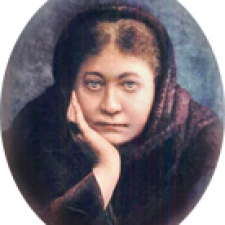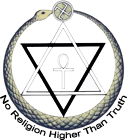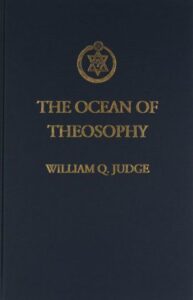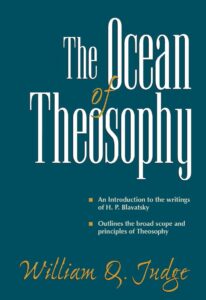Studies in The Ocean of Theosophy Part IV
Theosophy Magazine
Vol. 21, No. 4, February 1933
pages 165 - 167
Part IV
THE perspective opened in the second chapter of the “Ocean” reveals vast spans and far distances. Each listening ear that hears of evolution’s eternality begins to surmount restrictions placed by materialism and priestcraft. The enormous vistas depicted in ancient lore reduce to absurdity the chronology of modern teachings and grind their puerile ideals of human destiny to fragments. So much so that the learned ones of the immediate present are forced to push back their time limits markedly. Their conclusions are not so positive. Their statements seem less dogmatic. Archaeological discoveries are proving embarrassingly corroborative of Theosophical teaching. Even the clergy hasten to explain that the theological “six days” are not to be regarded as days of twenty-four hours, but represent “periods of time” — discreetly refraining, however, from disclosing the duration of these periods. Authorities are finding flexibility convenient and leeway necessary. This is well; for flexible bonds will stretch and, being so often stretched under pressure of unassailable doctrine and irrefutable evidence, must ultimately give way. It was to “break the molds of men’s minds” — religious, scientific, and philosophical — that H.P.B. came into this darkened world. She at least abolished mental subjugation. People are no longer afraid to think. But the great struggle with tenacious orthodox ideas is still to be undertaken by the majority.
He who enslaves another shackles himself. This is how the West became mentally bound. Here are reincarnated the Jews once held in bondage, together with the Egyptians who oppressed them and who, in their turn, are chained, mentally, to “Mosaic misunderstood tradition.” This affords an excellent illustration of the fact that Karmic effects are not fixed; for such enslavement could have been averted if the Westerner had held an open mind. The main channel for the flow of this retribution has been the conceit of modern investigators, possessed of “a singular unwillingness to take instruction from the records of Oriental people much older than the West.” With less pride and racial prejudice, “the living thought and record” of the despised Hindus might have been shared and real profit gained. Then the real age of the world, long “involved in doubt for Western investigators,” would have been known; for “with the Orientals is the truth about the matter.”
Truth is changeless and must eventually prevail. However much such evidence as the pyramids may have been distorted as to symbology or even ignored entirely, as in the prevailing Mosaic record, “where one would expect to find a reference to such proof”; and however much “the most learned even of our scientific men have stood in fear of the years that have elapsed since Adam, or have been warped in thought and perception whenever their eyes turned to any chronology different from that of a few tribes of the sons of Jacob”; nevertheless, through all this folly, there have stood many mighty monuments of an ancient past, such as “the noble, aged and silent pyramid of Gizeh, guarded by Sphinx and Memnon made of stone,” rapt in mystery, immovably awaiting “resurrection of the old pyramid builders of the Nile valley” and the recovery of “the plans of those ancient master masons,” “hidden from profane eyes until the cycle should roll round again for their bringing forth.” With the advent of Theosophy in the West this long awaited cycle dawned.
It is to the accounts of “a poor and conquered race” that Theosophy directs the attention of “the western flower of culture, war, and annexation” concerning “the age of man and his world.” These records at once upset “the interpretation so long given to the Mosaic tradition, but fully accord with the evident account in Genesis of other and former ‘creations'”. They also agree with the cabalistic construction of the Old Testament verse concerning “former periods of evolution” and “coincide with the belief held by some of the early Christian Fathers who told their brethren about wonderful previous worlds and creations.” Verily, the Christian “faith” would seem to be a house divided against itself.
In this “cosmic and human chronology of the Hindus,” “the periodical coming forth of great days and nights of equal length of the universe of manifested worlds” is symbolized as the Days and Nights of Brahma, implying that the universe exists for the Soul’s experience and indicating the vastnesses through which Soul evolution forever cycles onward. One “Day of Brahma” spans a period of “four billion three hundred and twenty million mortal or earth years.” His “year” extends in proportion; while His life-time covers an eternity of fifteen figures. During this time, the heterogeneous and differentiated evolves gradually from homogeneous matter, in three main stages of ethereal, astral, and material substance, while unfolding an innate seven-fold plan of progressive manifestation; thence gradually withdraws again into its Source, “the infinite and absolute unknown, which has no beginning and shall have no end; which is both last and first, because, whether differentiated or withdrawn into itself, it ever is” — the Deity, “around whose pavilion there is darkness.”
In all of this, there inheres one aim: the building of the human form, “Solomon’s Temple” — Dwelling of the Sun-Man; and one purpose: that Man may contact Nature, for his own experience and for her upliftment. This seven-storied temple is constructed of living materials, “found, gathered together and fashioned” during the general processes referred to. The human form, unique in nature, is the result of billions of years of sustained effort — continuation of similar effort on the Moon when still a planet. But if there be no Jehovah to oversee, who accomplished this construction? It was Man, the Sun-God himself, who for “many, many ages” worked “hidden from sight within, carrying forward the plans for the foundation of the human temple.” Then followed necessary training of the faculties and organs, and many more ages “for all the servants, the priests, and the counsellors to learn their parts properly so that man, the Master, might be able to use the temple for its best and highest purposes.” In this process, there were many stages, including types far different from the present shape, but each fitted to function, and serve a purpose, in the gradually condensing states of substance. All those temporary forms and their material elements are represented in the present human vesture — consummation and sum-total of them. But antedating this Holy Temple — ancient of days — and destined to survive it, even as He now dwells in it, moves ageless Man, the Builder, on his eternal, spiral Path of Progress.
COMPILER’S NOTE: The following is a separate item which followed the above article but was on the same page. I felt it was useful to include it here:
EVOLUTION-INVOLUTION
Though one and the same thing in their origin, Spirit and Matter, when once they are on the plane of differentiation, begin each of them their evolutionary progress in contrary directions — Spirit falling gradually into matter, and the latter ascending to its original condition, that of a pure spiritual substance. Both are inseparable, yet ever separated. In polarity, on the physical plane, two like poles will always repel each other, while the negative and the positive are mutually attracted, so do Spirit and Matter stand to each other — the two poles of the same homogeneous substance, the root-principle of the universe. —S.D. I, 247.
Back to The Ocean of Theosophy



